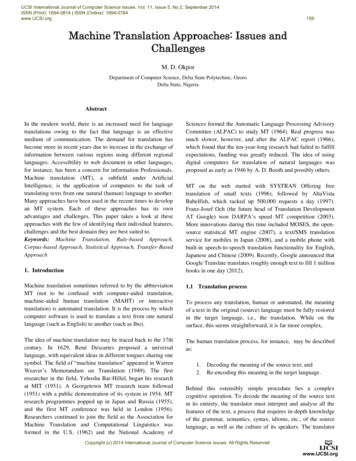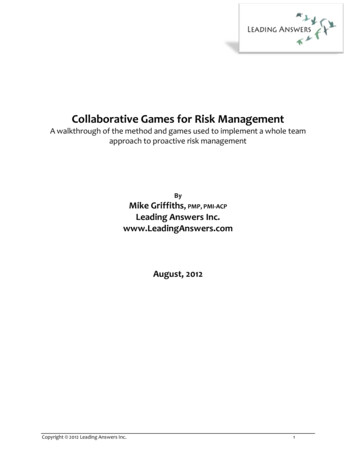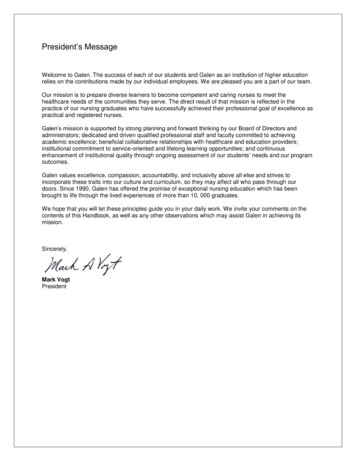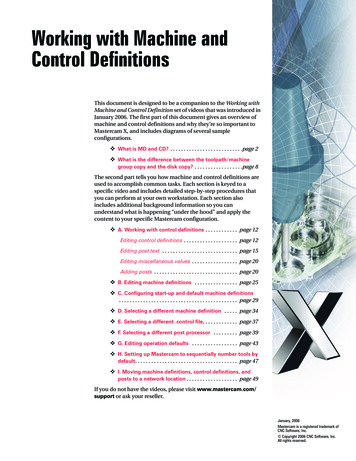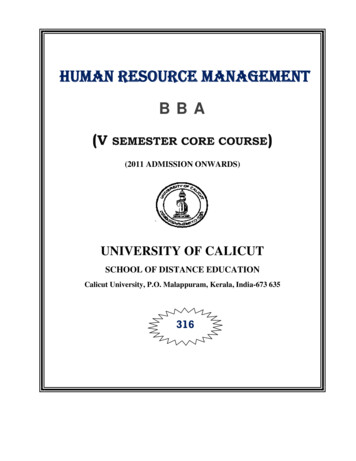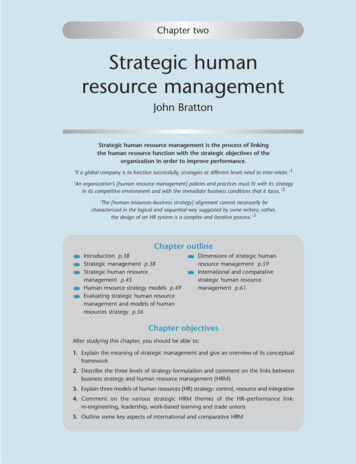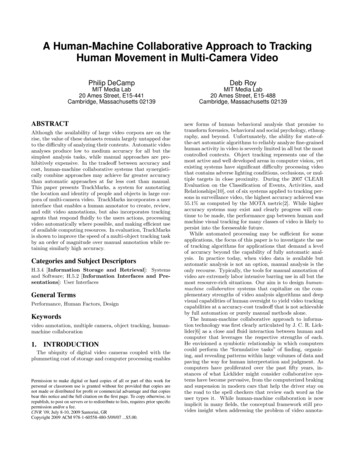
Transcription
A Human-Machine Collaborative Approach to TrackingHuman Movement in Multi-Camera VideoPhilip DeCampDeb RoyMIT Media Lab20 Ames Street, E15-441Cambridge, Massachusetts 02139MIT Media Lab20 Ames Street, E15-488Cambridge, Massachusetts 02139ABSTRACTAlthough the availability of large video corpora are on therise, the value of these datasets remain largely untapped dueto the difficulty of analyzing their contents. Automatic videoanalyses produce low to medium accuracy for all but thesimplest analysis tasks, while manual approaches are prohibitively expensive. In the tradeoff between accuracy andcost, human-machine collaborative systems that synergistically combine approaches may achieve far greater accuracythan automatic approaches at far less cost than manual.This paper presents TrackMarks, a system for annotatingthe location and identity of people and objects in large corpora of multi-camera video. TrackMarks incorporates a userinterface that enables a human annotator to create, review,and edit video annotations, but also incorporates trackingagents that respond fluidly to the users actions, processingvideo automatically where possible, and making efficient useof available computing resources. In evaluation, TrackMarksis shown to improve the speed of a multi-object tracking taskby an order of magnitude over manual annotation while retaining similarly high accuracy.Categories and Subject DescriptorsH.3.4 [Information Storage and Retrieval]: Systemsand Software; H.5.2 [Information Interfaces and Presentations]: User InterfacesGeneral TermsPerformance, Human Factors, DesignKeywordsvideo annotation, multiple camera, object tracking, humanmachine collaboration1.INTRODUCTIONThe ubiquity of digital video cameras coupled with theplummeting cost of storage and computer processing enablesPermission to make digital or hard copies of all or part of this work forpersonal or classroom use is granted without fee provided that copies arenot made or distributed for profit or commercial advantage and that copiesbear this notice and the full citation on the first page. To copy otherwise, torepublish, to post on servers or to redistribute to lists, requires prior specificpermission and/or a fee.CIVR ’09, July 8-10, 2009 Santorini, GRCopyright 2009 ACM 978-1-60558-480-5/09/07 . 5.00.new forms of human behavioral analysis that promise totransform forensics, behavioral and social psychology, ethnography, and beyond. Unfortunately, the ability for state-ofthe-art automatic algorithms to reliably analyze fine-grainedhuman activity in video is severely limited in all but the mostcontrolled contexts. Object tracking represents one of themost active and well developed areas in computer vision, yetexisting systems have significant difficulty processing videothat contains adverse lighting conditions, occlusions, or multiple targets in close proximity. During the 2007 CLEAREvaluation on the Classification of Events, Activities, andRelationships[10], out of six systems applied to tracking persons in surveillance video, the highest accuracy achieved was55.1% as computed by the MOTA metric[2]. While higheraccuracy systems may exist and clearly progress will continue to be made, the performance gap between human andmachine visual tracking for many classes of video is likely topersist into the foreseeable future.While automated processing may be sufficient for someapplications, the focus of this paper is to investigate the useof tracking algorithms for applications that demand a levelof accuracy beyond the capability of fully automatic analysis. In practice today, when video data is available butautomatic analysis is not an option, manual analysis is theonly recourse. Typically, the tools for manual annotation ofvideo are extremely labor intensive barring use in all but themost resource-rich situations. Our aim is to design humanmachine collaborative systems that capitalize on the complementary strengths of video analysis algorithms and deepvisual capabilities of human oversight to yield video trackingcapabilities at a accuracy-cost tradeoff that is not achievableby full automation or purely manual methods alone.The human-machine collaborative approach to information technology was first clearly articulated by J. C. R. Licklider[6] as a close and fluid interaction between human andcomputer that leverages the respective strengths of each.He envisioned a symbiotic relationship in which computerscould perform the “formulative tasks” of finding, organizing, and revealing patterns within large volumes of data andpaving the way for human interpretation and judgment. Ascomputers have proliferated over the past fifty years, instances of what Licklider might consider collaborative systems have become pervasive, from the computerized brakingand suspension in modern cars that help the driver stay onthe road to the spell checkers that review each word as theuser types it. While human-machine collaboration is nowimplicit in many fields, the conceptual framework still provides insight when addressing the problem of video annota-
tion. Given that humans can perform visual tasks with greataccuracy, and that computers can process video with greatefficiency, finding an effective bridge between the two mayyield an annotation system that process performs with muchgreater efficiency than manual annotation while making fewconcessions to accuracy.In this paper, we present TrackMarks, a human-computercollaborative system designed to annotate large collectionsof multi-camera video recordings. Specifically, this paperwill describe TrackMarks as applied to annotating personidentity and location, although the system may be adaptedto other video analysis tasks. When using TrackMarks, thehuman annotator begins the process by providing one ormore manual annotations on single frames of video. Thesystem then attempts to extend the user annotations intotracklets (partial track segments), filling in any sections ofthe data that are not completely annotated. To organizethis process, the system maintains a prioritized list of annotation jobs and dynamically assigns these jobs to trackingagents (computer processes that perform tracking). A single user can trigger a larger number of parallel tracking processes. As the system generates tracklets, the user may shiftto a verification and correction role. To support this role,the system supports interactive visualization of tracklets asthey are being generated tightly integrated with the abilityto issue corrections or additional annotations. With TrackMarks, users can fluidly interleave annotation, verification,and correction.The development of TrackMarks was motivated by thevideo analysis challenges posed by the Human SpeechomeProject (HSP)[8]. The project is an attempt to study childlanguage development through the use of very large collections of longitudinal, densely-sampled, audio-video recordings. In a pilot data collection, 11 ceiling-mounted fish-eyelens mega-pixel cameras and 14 boundary-layer microphoneswere installed in the home of a child. From the child’sbirth to three years of age, approximately 90,000 hours of14 frames-per-second video recordings were collected, capturing roughly 70% of the child’s waking experience at homeduring this period. In theory, given such a corpus, a scientific researcher should be able find and analyze events ofinterest to identify patterns of physical and social activity,compute aggregate statistics on aspects of behavior, or validate computational models of behavior and development.All of these tasks pose significant problems involving audiovideo indexing, retrieval, and analysis. TrackMarks is anattempt to dramatically reduce the cost of preprocessingsuch video collections so that they may be used for scientificinvestigation.There are existing systems that perform video annotationin a collaborative manner. Perhaps the one most similar toour own is described by Agarwala et al. in [1]. They describe a system for rotoscoping in which the user annotatesobject contours for two keyframes, the system interpolatesthe contours for the frames in between, after which the usercan review and correct the generated annotations. This system provides a more simple interaction in which the systemperforms one tracking job at a time and the user reviews theresults when the job is completed. In contrast, TrackMarksfocuses on running multiple trackers at once and enablingthe user to interact with the tracking processes while theyare running.Other approaches to tracking have included “two-stagetracking” systems, where the first stage involves the generation of high confidence tracklets, and the second stage determines how to aggregate the tracklets into longer tracks. In[9], the tracklets are combined automatically with a globaloptimization algorithm. In [5], Ivanov et al. describe a system that performs tracklet aggregation interactively witha human operator, which they refer to as “human guidedtracking.” In this system, tracklets are first generated frommotion sensor data and the system aggregates the trackletsfrom multiple sensors as fully as it can. When the systemcannot identify the correct tracklet sequence with sufficientconfidence, such as when two objects come too close togetherto be disambiguated from the motion data, it presents theuser with relevant video recordings and the user indicateswhich tracklets belong to a given target. While these systems may require far less manual labor than TrackMarks,they rely more on automatic tracking and require high confidence tracklets. TrackMarks has been developed to address worst case scenarios, in which sections of data mayneed to be annotated precisely, frame-by-frame. The moreautomatic systems still inform the future directions of TrackMarks, and possibilities for combining more automatic approaches will be discussed in Section 4.1.2.THE TRACKMARKS SYSTEM2.1Design GoalsThe purpose of TrackMarks is to identify and track multiple people from recordings taken from multiple camerasplaced in connected visual regions, but was also designedaround several additional objectives: Make annotation as efficient as possible while allowingthe operator to achieve an arbitrary level of accuracy. Annotate camera handovers (when a person moves outof view of one camera and into view of another), occlusions, and absences. (Absent events are defined ascases in which a known target is not in view of anycamera.) Provide an interface that is responsive enough to support fluid interaction between the operator and system. It is important that the automatic processes notimpede the operator’s ability to navigate and annotate the video. This requires that the response timefor frequent operations remain under a few hundredmilliseconds. Management for video collections larger than 100 TB.This affects database management, but also, for largecorpora, it is unlikely that a present day computer willbe able to access all of the data locally. When videodata must be accessed over a network, it poses additional problems in maintaining responsiveness.2.2User Interface OverviewFigure 1 shows a screenshot of the TrackMarks interface.The top, middle panel shows a typical frame of video in fullmega-pixel resolution. In this image, two bounding boxeshave been superimposed on the video that indicate the positions of a child and adult. The colors of the boxes indicatethe identity of each person. Video navigation is performedprimarily with a jog-shuttle controller.
Figure 1: TrackMarks InterfaceThe top, left panel displays video thumbnails from theother cameras in the house. The user selects the videostream to view by clicking one of these thumbnails.The bottom panel shows a timeline visualization of theannotations that resembles a subway map. This componentsummarizes the annotations that have been made, providingthe user with a method of identifying and accessing portionsof the data that require annotation. The horizontal axis represents time, which consists of approximately 30 minutes ofdata in this example. The blue, vertical bar indicates theuser’s position in the video stream. The timeline is dividedinto horizontal “channels,” each representing one camera, demarcated by the thin black lines. The top channel, coloredgray, represents the “absent” channel that is used to indicatethat a target is not present in any of recordings. Finally,the thick, colored lines represent the tracklets. As with thebounding boxes superimposed on the video, the tracklets arecolored to indicate person identity. The vertical placementof the tracklet indicates the channel, so when a tracklet linemakes a vertical jump to another channel, it indicates thatthe target moved to a different camera at that place in time.As the system generates annotations, the timeline map addsor extends these tracklet lines and the user can monitor theprogress of the system. Note that each bounding box shownon the video frame corresponds to a thin slice from one ofthe tracklet lines on the timeline view.2.3Track RepresentationTrack data is represented in a hierarchical structure withthree levels: track points, track segments, and tracklets. Atthe lowest level, track points correspond to an annotationassociated with a single frame of video. For the instanceof the system described in this paper, all track points consist of bounding boxes. Track points are grouped into tracksegments, which represent a set of track points for a contiguous sequence of video frames from a single camera. Tracksegments may also indicate that a target is occluded or absent for an interval of time, and that no track points areavailable. Adjoining track segments are grouped into tracklets. Tracklets specify the identity of the target and combinethe track data for that target across multiple cameras for acontinuous time interval.Several constraints are placed on the track data to simplifythe system. First, only one annotation may be created fora given target in a given time frame. It is not possible toindicate that a target simultaneously occupies more thanone location or camera, and multiple tracklets for a giventarget may not overlap. This precludes the use of multiplehypothesis tracking algorithms or annotating multiple viewsof the same object captured by different cameras, but greatlysimplifies interaction with the system because the user doesnot need to review multiple video streams when annotatinga given target.Second, each tracklet has a single key point that is usuallya track point created by the user. The tracklet originatesfrom the key point, and extends forward and backward intime from that point. The purpose of the key point is tosimplify tracklet editing. When deleting a track point froma tracklet, if the track point is defined after the key point, itis assumed that all of the tracklet defined after the deletedpoint is no longer valid and the right side of the tracklet istrimmed.2.4Annotation ProcessThis section outlines the annotation process from the viewof the human annotator. To begin the process, the userselects an assignment to work on, where the assignmentdefines an objective for the user and a portion of data toprocess. The user browses the video and locates a target.Target identification is performed manually. The jog-shuttlecontroller used to navigate the video has nine buttons thatare mapped to the most frequently occurring targets. Theuser may quickly select the identity by pressing the corresponding target button, or, more slowly, may evoke a popupmenu that contains a complete list of targets as well as anoption to define new targets. Given the overhead positionof the cameras, it is sometimes necessary to browse througha portion of the data before an identification may be made.After identification, the user uses a mouse to draw a bounding box that roughly encompasses the object as it appearsin the video. If the annotation appears correct, the usercommits the annotation.When the user commits an annotation, it creates a newtrack point as well and a new tracklet that consists of onlythat point. By default, TrackMarks automatically attemptsto extend the tracklet bidirectionally. This process is described in Section 2.5. Camera handover is performed manually, and the user must create annotations at time frames inwhich a target enters or leaves a room. Usually, when annotating a target entering a room, the user defines a trackletthat should be extended forward in time, but should notbe extended backward because the target will no longer bethere. For this reason, it is also possible for the user to specify that a tracklet be extended only forward, only backward,or not at all.While tracking is being performed, the operating mayskim the video stream and verify the generated annotations.If a mistake is found, the user may click on the incorrecttrack point and delete it, causing the tracklet to be trimmedback to that point, or may choose to delete the tracklet altogether. More commonly, the user may draw a new boundingbox around the target and commit the correction, causingthe incorrect annotation to be deleted and restarting thetracking process for the target at that frame.In addition to making position annotations, the user mayindicate that a target is occluded or absent. Occlusions and
absences are indicated in an identical process, and both arereferred to as occlusion annotations. Unlike the position annotations that are associated with a single frame, occlusionannotations may cover an arbitrary period of video. Ratherthan require the user find both the beginning and end of theannotation, which might require searching through a greatdeal of video and disrupt the user’s workflow, the user markseach end of the annotation separately. Assuming that theuser is navigating forward through a video stream and identifies the first time frame where a target becomes occluded,the annotator selects the target identity and presses a buttonon the jog-shuttle controller that indicates the selected target is occluded from that frame onward. This creates a newtracklet that starts from the user’s time frame and extendsas far as possible without overlapping existing annotationsfor the same target. When the user reaches the later timeframe where the target becomes unoccluded, he can createa new annotation at that frame, effectively trimming theoriginal occlusion annotation. In the timeline view shown inFigure 1, occlusion tracklets are distinguished from normaltracklets by using hollow lines.2.5Tracking AgentsWhile there are many possibilities for improving annotation efficiency through faster hardware or improved tracking algorithms, our work focuses on improving performancethrough structured collaboration. Having an efficient trackerimplementation is still important, but large gains can be hadby scheduling the tracking processes intelligently to minimize redundant operations, to provide rapid feedback to theuser so that errors are corrected quickly, and to prevent thesizable computational resources required for object trackingfrom interfering with the interface. The key optimizationmade by TrackMarks, then, is the tracking agent subsystemthat manages and executes tracking tasks.The tracking process may be broken into four steps, inwhich tracking jobs are defined, prioritized, assigned, andexecuted. This is not a linear process; jobs may be revisedor cancelled at any time. The tracking agent subsystem thathandles this process consists of four levels: a job creator, ajob delegator, job executors, and trackers.The job creator receives all requests to expand trackletsand defines a job for each request. For convenience, thebackward time direction is referred to as left, and the forwardas right. Each job is associated with a tracklet ri , wherethe purpose of the job is to add annotations to expand thetracklet in either the left or right direction, di {0, 1}. Theleft and right edges of the tracklet occur at times ti,0 andti,1 , respectively, and the job is complete when the edge ti,diis extended to a goal time, ti,di t̃i .The main parameter to compute is the goal time. t̃i isselected such that the tracklet is extended as far as possiblewithout overlapping existing tracklets with the same target.Assuming tracklet ri is being extended to the right di 1,the job creator finds the first tracklet rj that exists to theright of ri and shares the same target. If there is no such rj ,then t̃i may be set to the end of the available video stream.If rj does exist, then t̃i is set to the left edge of that tracklett̃i tj,0 .In the case where rj is being extended backwards by another job, then the goal time of both jobs is set to the timehalf way between ri and rj , splitting the remaining loadbetween the two jobs, t̃i , t̃j 0.5(ti,1 tj,0 ).Tracklets may be created and altered while tracking occurs. The job creator is notified of all such events and recomputes the goal times t̃ for all jobs that might be affected.If the operator deletes an annotation that was created by ajob that is still being processed, that job has failed and isimmediately terminated.All existing jobs are given to the job delegator, whichschedules jobs for execution. In the case of TrackMarks, thetime required to perform person tracking is a small fraction of the time required for retrieving and decoding thevideo. Subsequently, the greatest gains in efficiency resultfrom tracking as many targets as possible for each frame ofvideo retrieved. The job delegator exploits this by mappingall jobs into job sets that may be executed simultaneouslyby processing a single contiguous segment of video, prioritizing each job set, and assigning the highest priority sets tothe available executors.The process of grouping jobs into sets can be formulated asa constraint satisfaction problem. Each job bi is associatedwith a segment of video to process, defined by a cameraci and time interval ri . For forward jobs with di 1, theinterval is si [ti,r , t̃i ]. For jobs with di 1, si [t̃i , ti,0 ].Each job set, B, is must meet three constraints: Forward and backward tracking jobs cannot be combined, nor can jobs that access video streams generatedfrom different cameras. bi B bj B di dj ci cj . Jobs with non overlapping intervals cannot be processed together. The union of time intervals for alljobs in a set i,bi B si must be interval. A job cannot belong to a set if the tracklet edge beingextended by that job is too distant from the other jobsin the set. bi B bj B tri trj τ , where τ is a chosenparameter.When a job bi is first created, the delegator attempts tolocate an existing job set, B, to which the job may be addedwithout violating any constraints. If no such set can befound, a new set is created containing only one job. Eachtime a job as added or otherwise altered, the constraints arereapplied, causing job sets to be split and joined as needed.The algorithm used to solve this constraint problem involvesimplementation details and is of less interest than the formulation of the problem itself.
Job CreatorJob DelegatorJob ExecutorsTrackersFigure 2: Tracking Agent Subsystem. The job creator manages individual tracking jobs. The delegator organizes the jobs into sets. Each executorprocesses one set of jobs, feeding video frames toone tracker per job.Each time a job set is altered, the job delegator recomputes a priority for that set. The priority is based first onprocessing jobs sets such that they are likely to reach another job set, allowing them to merge and thus reduce computational load. Second, higher priority is given to job setsthat are processing data at earlier time frames, encouragingtracking to be performed from left to right. This criteriahelps to reduce the fragmentation of tracklets, and reducesthe amount of time the user expends reviewing video. Othercriteria might also be incorporated at this stage. Givinggreater priority to the recency of the jobs might help toplace trackers near the locations that the user is annotating,improving the perceived responsiveness of the system.After the job sets are prioritized, the top n sets are assigned to job executors. The parameter n thus determinesthe number of tracking threads running at any point in time,and the portion of resources allocated to tracking. Each executor runs in an isolated thread, executing all jobs in theset bi B simultaneously. The executor initializes a trackerfor each job. Job sets may be altered while the executor isrunning and not all jobs in the set are necessarily aligned.For forward tracking job sets, bi B di 1, the executoralways retrieves the earliest frame of video to be processedby any job, tf minbi B ti,1 , passing that frame to eachtracker that has not already processed it. The resulting behavior is that the executor may sometimes “jump backward”in the video stream and reprocess a segment of video untilthe earliest job catches up to the others.The trackers are then conceived as passive componentsthat produce one track point that indicates the locationof one target for each video frame provided. The positiontracker used is built on the mean-shift tracking algorithm[4]. Mean-shift tracking is performed by adjusting the sizeand location of a bounding box to maintain a consistent distribution of color features within the box. This algorithmwas chosen partially for its relatively fast speed. However, itwas also chosen over motion-based algorithms because it waspredicted that people in a home environment would spendmuch more time sitting in place, as compared to people ina public space that might spend more time traveling. Additionally, when tracking a child being held by a caregiver, thetwo targets may be separated more reliably by color than bymotion. While the implementation used relies more stronglyon color features, motion features were not discounted entirely, and the tracking algorithm does incorporate a fastforeground-background segmentation step to improve performance for targets in motion.The end result of the tracking agent system is a structuredbut fluid interaction between the user and system. As theuser creates annotations, TrackMarks propagates them tocreate a set of tracklets that cover the full range of data forall targets. As it performs tracking, TrackMarks attemptsto reduce the fragmentation of the data, combines trackingjobs when possible to greatly reduce the computation timerequired, and continuously indicates tracking progress in theuser interface. When the user makes a correction, the tracking agents remove any jobs that are no longer useful andcreates new jobs to propagate the correction. The trackeragents afford the user flexibility in annotating the data. Indifficult cases where the tracking fails often, the user primarily focus on reviewing and correcting annotations. In otherinstances, the user may skim through the video and providea few annotations, and return later to review the results. Inthe worst cases in which tracking fails completely, the userstill has the ability to annotate manually.3.EVALUATIONTo test the efficiency of TrackMarks, three hours of multichannel video recordings were selected from the speechomecorpus for transcription. The selected data was broken intosix, 30 minute assignments. To select assignments of interestthat contained high levels of activity, the data was selectedfrom the 681 hours of data for which speech transcripts wereavailable, allowing the activity levels of the assignments tobe estimated by examining the amount of speech activity.The data from this subset was collected over a 16 monthperiod, during which a child and family was recorded whilethe child was between the age of 9–24 months. The 1362 assignments were ordered in a list according to a combinationof activity level and distribution of collection dates, and asequence of six assignments was selected from near the topof that list (positions 18–24). Figure 3 shows several videoframes taken from the transcribed data.Annotators were given the same objective for all assignments: to fully annotate the position and identity of thechild for the entire assignment, and to annotate all otherpersons within sight of the child’s position, including personsvisible to the child through open doorways. The annotatorswere instructed to fix all incorrect annotations. Annotations(drawn as bounding boxes) were deemed correct if the boxcontained at least half of the target object, and that it wouldnot be possible to reduce the area of the bounding box byhalf without also removing part of the object. Targets weremarked occluded if less than half of the target object was vis-
Figure 3: Example AnnotationsA1 time (minutes)A2 time (minutes)Strict IAA MOTAIAA MOTAIAA MOTPObject CountObjects Per FrameManual AnnotationsForced ErrorsUnforced le 1: Annotation Trial Resultsible, and absent if the target was not present in any roomsbeing recorded.The evaluation was performed by two annotators. Annotator A1 (first author) had previously annotated approximately five hours of video with TrackMarks. Annotator A2was given two warmup assignments that are omitted fromthe evaluation. Results are shown in Table 1.The first two rows present the annotation time requiredby both annotators, A1 and A2. The speed of the annotators fell between 28.3% and 133% of the speed required toannotate the data in realtime, with a overall mean of 55.4%.That is, 108 minutes of labor was required on average toannotate 60 minutes of recordings.Rows three through five present the inter-annotator agreement computed with the CLEAR MOT metrics[10]. TheMOT metrics provide a standardized method for computingthe accuracy (MOTA) and precision (MOTP) of multi objecttracking systems. The MOTA score indicates the percent ofcorrect matches, taking into account t
Given that humans can perform visual tasks with great accuracy, and that computers can process video with great e ciency, nding an e ective bridge between the two may . Other approaches to tracking have included \two-stage tracking

